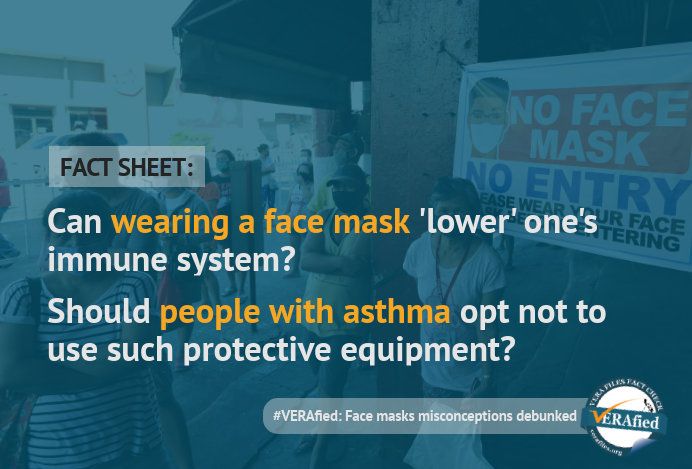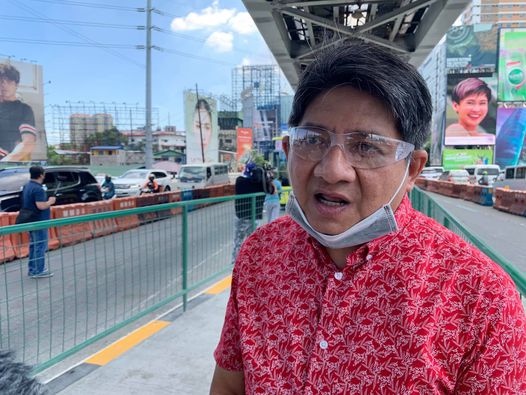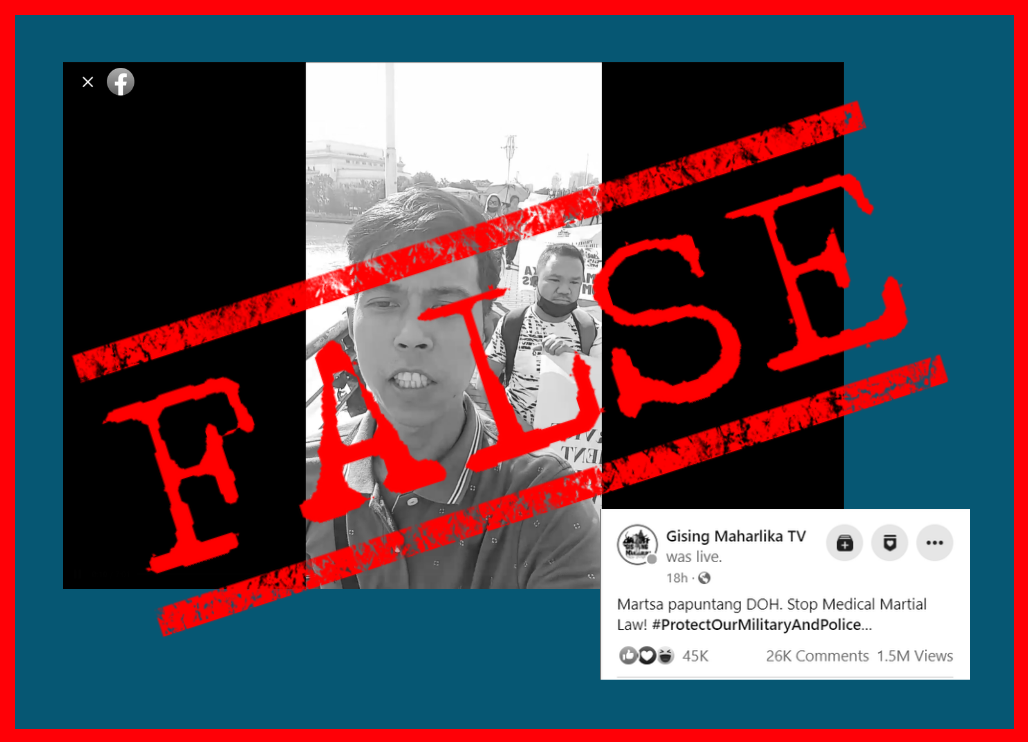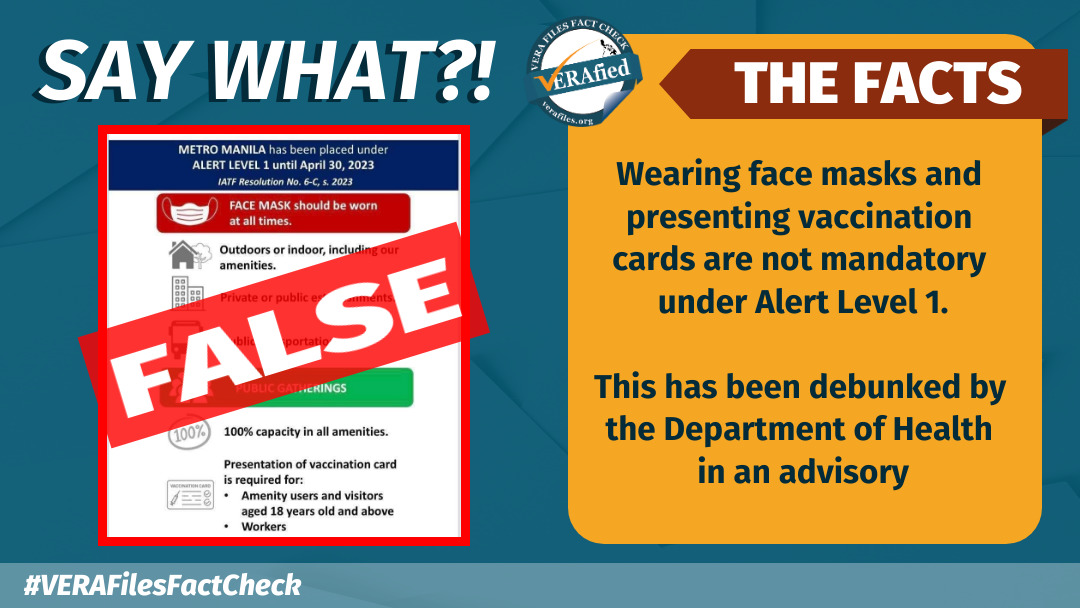It has been four months since the government mandated the wearing of face masks outside residences to lessen the transmission of the coronavirus disease 2019 (COVID-19), yet some officials still give wrong advice on how to use the protective cover.
President Rodrigo Duterte, for one, repeatedly advised the use of gasoline or diesel to disinfect masks — which can be hazardous to one’s health. (See VERA FILES FACT CHECK: Duterte negates spox; repeats wrong, unsafe claim on using gasoline as disinfectant)
Health Secretary Francisco Duque III was not spared by netizens when he was called out for improperly wearing a mask below his nose during a televised meeting with the Inter-Agency Task Force on Emerging Infectious Diseases (IATF-EID) on July 16.
In June, Cebu Governor Gwendolyn Garcia claimed, among others, that wearing masks lowers one’s immune system and causes lethargy due to lack of oxygen.
Before wearing face masks was required in April, Manila Vice Mayor Sheilah “Honey” Lacuna-Pangan wrongly said in January that there were two ways to wear surgical masks, depending on whether a person is sick or not. This was disproved by reputable health institutions. (See VERA FILES FACT CHECK: Manila Vice Mayor Lacuna demos wrong way to wear surgical masks, calls it the ‘proper’ way)
VERA Files listed and debunked some misconceptions, including those made or spread by public officials, on the proper use of face masks.
Claim 1: Face masks make the wearer ‘breathe back carbon dioxide,’ thus causing ‘lethargy and dizziness’
Fact: Medical masks, such as N95, are “porous,” pulmonologist Camilo Roa, former president of the Philippine College of Chest Physicians, told VERA Files in an interview.
Medical masks and filtering facepiece respirators (FFR) filter particles but not gases, Roa said. “Gases can pass through freely” unless the person is using a plastic mask that “does not allow oxygen or any gas to get through,” he said in a mix of English and Filipino.
Claims that prolonged use of masks cause oxygen deficiency, carbon dioxide intoxication, or other health challenges are “not grounded in science,” a team of public health experts convened by international nonprofit Meedan told VERA Files.
Similarly, in an earlier interview, WHO told VERA Files that “there is no evidence to show that prolonged use of face masks causes adverse effects on the brain or heart functioning.” (See VERA FILES FACT CHECK: Prolonged mask use DOES NOT cause hypoxia)
A 2013 study recorded in the United States (U.S.) National Library of Medicine website involving 10 nurses who wore N95 masks during full 12-hour shifts showed evidence disputing the claim.
Experiencing breathing difficulties and not getting enough air is “likely a response to stress or anxiety of wearing a mask,” Meedan experts said. In such cases, they said focusing on normal breathing patterns can help.
Shallow breathing, hyperventilation, and breath holding can cause increases in carbon dioxide, which, in turn, leads to headaches and nausea — symptoms that are “generally not caused by the use of masks,” Meedan experts added.
Claim 2: Inhaling carbon dioxide while wearing a mask causes ‘overall exhaustion’ and ‘lowers’ the immune system
Fact: There is “absolutely no scientific evidence that mask-wearing or physical distancing weakens the immune system,” according to the American Lung Association.
Roa, also a global governor of American College of Chest Physicians for the Philippines, said carbon dioxide “does not stay inside the mask” and will go out because masks have “very small residual volume.” When the person inhales, “only a little exhaled air is rebreathed back to the lungs,” and “exhaled stale air” goes back to the environment air, he said.
Airtight medical masks are “designed for constant breathing,” hence, “risks of any side effects are low,” Meedan public health experts said.
While carbon dioxide detention or too high carbon dioxide, as seen in some patients, can make people sleepy, one’s immune system “is not directly impacted,” Roa added. This applies specifically to people who breathe a fourth of what they should, he said.
Meedan experts said wearing airtight masks for those with specific health issues, such as chronic obstructive pulmonary disease, or who are heavy smokers “can make breathing more difficult” and that they should consult their healthcare providers on such challenges.
They added that there is “no evidence to suggest” that cloth masks cause suffocation.
Claim 3: People with asthma cannot wear masks for long periods of time
Fact: People with asthma “should wear face masks, as studies have shown masks do not reduce oxygen levels and should not make breathing more difficult,” Meedan public health experts said.
Moreover, Roa said SARS-CoV-2, the virus that causes COVID-19, can sometimes trigger an attack, hence asthmatics need to have a mask in addition to their medicines for asthma. “If necessary, oxygen can be given using the nasal catheter and a surgical mask can be worn over it to minimize generating aerosols that can carry the virus and spread it,” he said.
However, those with severe cases of asthma, wearing a mask can be a challenge, Meedan experts said. Citing the Asthma and Allergy Foundation of America, they suggested either:
- wearing homemade face masks with three layers that would not fit too tightly, using 100 percent cotton t-shirt material as much as possible; or,
- tying something across one’s nose that hangs freely, shielding the nose and mouth.
In instances when asthma attacks are severe, Roa said individuals must follow their doctors’ advice, or go to the nearest health facility.
If a person with severe asthma cannot wear a mask “due to difficulty in breathing in general,” Meedan public health experts said:
“…other options like using food delivery services, avoiding crowds and travel, and staying home as much as possible are ways you can protect yourself from COVID-19.”
Claim 4: Mini, portable air purifier necklaces may be used as alternative to face masks to prevent COVID-19
Fact: Mini, portable air purifier necklaces, such as the type sold in consumer websites, have not been shown to prevent COVID-19 infection as there have been no studies about these devices to date, Meedan experts said.
According to Roa, the devices worn around the neck are “too small to clean inhaled air” and “do not take the place of masks.”
The U.S. Environmental Protection Agency said air purifiers can help “reduce” airborne contaminants, including viruses, in a home or confined space. However, a portable air cleaner by itself is “not enough” to protect people from COVID-19.
Claim 5: There are two ways of wearing a surgical mask, depending on whether you are sick or not.
Fact: There is only one proper way to wear surgical masks: with the waterproof (usually colored) side facing out.
In a Jan. 24 Bloomberg interview, World Health Organization (WHO) Collaborating Center for Infectious Disease Epidemiology and Control Director Seto Wing Hong of Hong Kong University said the right way to wear a surgical mask is to have the blue color on the outside and the white on the inside.
He said the blue or colored side of the mask is waterproof, while the white side is absorbent. (See VERA FILES FACT CHECK: Manila Vice Mayor Lacuna demos wrong way to wear surgical masks, calls it the ‘proper’ way)
Claim 6: Gasoline, diesel can be used to disinfect masks
Fact: Gasoline and diesel — both considered toxic substances — are not recommended by health experts to be used as disinfectants.
Inhaling gasoline may “cause asphyxiation in enclosed, poorly ventilated, or low-lying areas,” according to an explainer by the U.S. Centers for Disease Control and Prevention (CDC).
Repeated or prolonged skin contact may also cause irritation, or first- and second-degree burns, it added.
Breathing large quantities of diesel vapor, on the other hand, may cause dizziness, headaches, drowsiness, and incoordination, among others, according to WHO.
Claim 7: Face masks are reusable
Fact: While cloth masks may be used more than once, medical masks, such as N95, are for single-use only and should be discarded properly after eight hours or when already soiled, according to WHO.
In a July 21 presser, Health Undersecretary Maria Rosario Singh-Vergeire said cloth or fabric masks must be washed with soap and water after every use and hung dry under direct sunlight.
Single-use masks, on the other hand, cannot be washed nor wet as certain “filtering mechanisms” might lose its effectiveness, Vergeire added.
Guidelines on wearing masks
WHO, in its updated guidelines on the use of masks, enumerated the composition of each layer of the fabric masks: inner layer must be absorbent, such as cotton; middle layer must be non-woven material like polypropylene; and, outer layer should be non-absorbent, like polyester or polyester blend. It also released an interim guidance on masks that can be found here.
According to a CDC explainer, masks “should not be worn” by children younger than 2 years old, anyone who has trouble breathing, or anyone who is unconscious, incapacitated, or unable to remove the mask without assistance.
Wearing personal protective equipment, such as masks and face shields, is only a risk reduction measure not a risk avoidance, according to Meedan. Maintaining hygiene, physical distancing and other measures are still recommended.
Using face shields
Starting Aug. 15, the Department of Transportation will require public transportation passengers to wear face shields, in addition to masks.
In a taped address aired on July 31, Presidential Spokesperson Harry Roque said wearing face shields was now among the four minimum health standards, along with washing of hands, wearing masks, and physical distancing.
An opinion article published in the Journal of American Medical Association (JAMA) on April 29 said face shields should be included as part of strategies to “safely and significantly reduce transmission” of COVID-19 in a community setting, and that it may “provide a better option” than cloth masks in place of medical masks.
It cited a 2014 simulation study on efficacy of face shields against cough aerosol droplets reducing the viral exposure to 96 percent. The JAMA piece, penned by Eli Perencevich of Iowa City Health Care System, noted, however, that no studies have evaluated the effects or potential benefits of face shields if the source person coughs or sneezes.
The simulation study said it can be a “useful adjunct” to respiratory protection of workers but not as a substitute.
CDC and Massachusetts Institute of Technology do not recommend the use of face shields as a substitute for masks. CDC added that disposable face shields should only be worn once. Reusable face shields should be cleaned and disinfected after each use.
Sources
Presidential Communications Operations Office, Inter-Agency Task Force Virtual Presser with Cabinet Secretary Karlo Nograles, April 2, 2020
Department of the Interior and Local Government, Memo Circulars: Mandatory Wearing of Face Masks or other Protective Equipment in Public Areas, April 9, 2020
Official Gazette of the Philippines, Omnibus Guidelines on the Implementation of Community Quarantine in the Philippines with Amendments, July 16, 2020
Presidential Communications Operations Office, Talk to the People of President Rodrigo Roa Duterte on Coronavirus Disease 2019 (COVID-19), July 21, 2020
Interaksyon, Viewers of Duterte’s national address blast Duque for improper wear of face mask, July 16, 2020
RTVMalacanang Official Youtube, Kumusta Po Mahal Kong Kababayan? | President Rodrigo Roa Duterte’s Meeting on COVID-19, July 15, 2020
Personal communication with Dr. Camilo Roa, July 15, 2020
Personal communication with Meedan health experts, July 17, 2020
Properly wearing of surgical mask
- Trending ni Andres Youtube account, Live Update Corona Virus Alert from Isko Moreno, Jan. 23, 2020
Face masks and breathing back carbon dioxide
- Gov. Gwen Garcia Official Facebook, Gov. Gwen Garcia together with her Chief of Staff lawyer Frank Duke Dinsay…, June 4, 2020
- United States Food and Drug, N95 Respirators, Surgical Masks, and Face Masks, June 7, 2020
- United States Centers for Disease Control and Prevention, PPE FAQ: Respirators, July 22, 2020
- Rebmann, T., Carrico, R.,Wang, J. (2013). Physiologic and other effects and compliance with long-term respirator use among medical intensive care unit nurses. Retrieved on August 5, 2020
- United States National Institutes of Health: National Library of Medicine, Physiologic and other effects and compliance with long-term respirator use among medical intensive care unit nurses
Face masks does not weaken immune system
- American Lung Association, From the Frontlines: The Truth About Masks and COVID-19. Do masks cause low oxygen levels?, June 18, 2020
- American College of Chest Physicians Philippine Delegation, History
- Oxford University’s Lexico, residual volume
- Asthma and Allergy Foundation of America, What People With Asthma Need to Know About Face Masks and Coverings During the COVID-19 Pandemic, June 16, 2020
Mini portable air purifier necklaces are not alternatives to face masks
- United States Environmental Protection Agency, Will an air cleaner or air purifier help protect me and my family from COVID-19 in my home?
Gasoline and diesel are not disinfectants
- Agency for Toxic Substances and Disease Registry, Toxic Substances Portal: Gasoline Automotive
- Agency for Toxic Substances and Disease Registry, Toxic Substances Portal: Fuel Oils/Kerosene
- Agency for Toxic Substances and Disease Registry, Toxic Substances Portal: Medical Management Guidelines for Gasoline
- World Health Organization, Health Protection Agency: Compendium of Chemical Hazards: Diesel. Frequently Asked Question: If there is diesel in the environment will I have any adverse health effects?
Reusing face masks
- World Health Organization, Coronavirus disease (COVID-19) advice for the public: When and how to use masks, June 19, 2020
- Inquirer.net YouTube, Reuse face masks? DOH says Duterte referring to cloth masks; disinfection by gasoline maybe a joke, July 21, 2020
- United States Centers for Disease Control and Prevention, NIOSH Science Blog: N95 Respirators and Surgical Masks, Oct. 14, 2009
World Health Organization, WHO updated guidance on the use of masks: How to choose a fabric mask, June 12, 2020
World Health Organization, Advice on the use of masks in the context of COVID-19, June 5, 2020
United States Centers for Disease Control and Prevention, Considerations for Wearing Masks: Who Should Not Wear a Mask, July 16, 2020
Meedan COVID-19 Expert Database, Why should we all be wearing masks?, July 27, 2020
Using face shields
- Presidential Communications Operations Office, Talk to the People of President Rodrigo Roa Duterte on Coronavirus Disease 2019 (COVID-19), July 31, 2020
- Perencevich EN, Diekema DJ, Edmond MB (2020). Moving Personal Protective Equipment Into the Community: Face Shields and Containment of COVID-19. Retrieved on Aug. 5, 2020
- Lindsley WG, Noti JD, Blachere FM, Szalajda JV, Beezhold DH (2014). Efficacy of face shields against cough aerosol droplets from a cough simulator, Retrieved on Aug. 5, 2020
- Massachusetts Institute of Technology, Face shield instead of mask?, July 1, 2020
- ABS-CBN News, Philippines requires wearing of face shields in public transportation from Aug. 15, Aug. 5, 2020
- CNN Philippines, DOTr to require wearing of face shields among passengers in areas where public transpo is allowed, Aug. 4, 2020
- GMA News Online, Mandatory wearing of face shields in public transportation to be required soon, Aug. 5, 2020
- Department of Transportation Official Facebook, DOTr implements mandatory use of face shields for all passengers using public transportation, Aug. 5, 2020
(Guided by the code of principles of the International Fact-Checking Network at Poynter, VERA Files tracks the false claims, flip-flops, misleading statements of public officials and figures, and debunks them with factual evidence. Find out more about this initiative and our methodology.)




